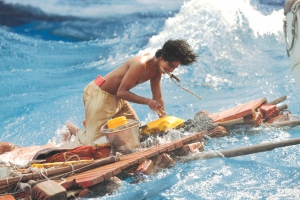| Home - Back Issues - The Team - Contact Us |
 |
| Volume 12 |Issue 09| March 01, 2013 | |
|
|
Perceptions LIFE OF PI REVIEW
Pial Islam and Seama Mowri “The world isn't just the way it is. It is how we understand it, no? And in understanding something, we bring something to it, no? Doesn't that make life a story?” And what a story Yann Martel spins, in the form of a 16-year-old boy, a tiger and the Pacific Ocean. A visually gorgeous adaptation of the bestseller by director Ang Lee that fetched him the best director award as well as three other awards to the Oscars this year boosted the book's outreach in terms of both numbers and numerous thought – provoking discussions. At the centre of this intriguing novel is Pi (short for Piscine, a famous swimming pool in Paris) Patel, a charming Indian boy growing up in and around his family's zoo in Pondicherry, the former capital of French India. Much of his childhood revolves around understanding faith: Hindu by birth, Pi soon adds Christianity and Islam to his belief system much to his parents' chagrin. Hard times in India prompt Pi's father to announce a move to Canada, where he plans to sell off the zoo animals. However, the ship is hit by a nocturnal storm and as the air clears, the only survivors sharing space on a 27-foot lifeboat are Pi, an injured zebra, a maniacal hyena, an orangutan and, hidden from sight under a tarp, a Royal Bengal tiger named Richard Parker. Hunger and the law of the jungle assure that the population onboard is shortly reduced to two. And this is where the story– telling really begins. The next 227 days of floating journey is marked by adventurous ordeals that test the wits of both man and beast in the open sea.
Even though the plot revolves around a marine adventure with a certain spiritual dimension, there's one other aspect that speaks throughout and speaks strong: Strategy. The complexities of surviving seven months on a lifeboat in the close proximity of a ferocious tiger attest that strategy was an integral part of Pi's survival, much like it is for any business. Allow us to pinpoint where some of the similarities intersect and how Life of Pi provides important business strategy lessons for entrepreneurs today. Keep an Open Mind The lesson here is simple. As far as management models are concerned, bring a nearly blank slate to adventure and apply whatever works best. Like Pi Patel, an entrepreneur should experience and embrace the unique aspects of as many management mantras that appeal to the business, instead of being stuck with an age-old model that may no longer be relevant. No single management model is a guaranteed harbinger of success, and just because it worked once doesn't mean it'll work again. Here is a case in point. Many strategy books from the North profess identifying the core competencies of a firm and focusing almost singularly on activities related to those competencies, while outsourcing the rest of activities in the value chain to other firms. The experience on this in the South is mixed. Many of the highly successful businesses in the South are conglomerates, with widely diverse set of portfolios and where many or all of the activities in the value chain are carried out by those conglomerates. Neither model is always right or always wrong. It's important to figure out what works for a particular business given a particular set of circumstances and adopt that approach. Embrace Risks Judiciously The lesson is clear. Follow your curiosities. Try things out of the ordinary. Embrace risks. But embrace them judiciously. Big risks in business context often stem from activities such as entering new markets, introducing fundamentally different products, or turning an established business model on its head. Judicious risk taking requires combining conscious risk taking with structured risk mitigation strategies. Seek Unconventional Partners
Successful businesses are built on the strength of partnerships, whether formal or informal. Examples of conventional partnerships are all around us. An airline partners with a credit card company for loyalty programmes. An auto manufacturer partners with a financial institution to finance car purchases. But unconventional partnerships are relatively rare. A recent partnership between a German shoe company and a Bangladeshi NGO to create a social venture to address a global healthcare problem is one such example. Unconventional partnerships result from deep understanding of the core competencies and value chains of partner organisations as well as clear articulation of the goals, often leveraging disruptive innovations. Embrace Change For businesses, change occurs in a number of ways. New government regulations may affect a business's profitability by imposing new compliance regulations. New technology may render a business obsolete if they fail to adapt or incorporate the know-how into their business model. New competition, or even an improved old competitor, is a market change that businesses cannot afford to overlook or ignore. Change is in fact a constant phenomenon that organisations need to embrace and capitalise on. Focus on the Big Picture Moving a company forward takes more than just managing the day-to-day affairs of the business. It requires a dogged focus on the big picture. Even when the company enjoys short-term benefits of a product, it should not give up the constant analysis of activities, opportunities and threats with the long-term view in perspective. Similarly, when things are bad, a company should not simply resort to cost-cutting measures. In fact, a large computer chip manufacturer is known for its strategy to invest heavily in downturns. It takes advantage of lower input costs during downturns and develops new products that are launched at the first sign of market recovery. Tales of lonely survival often have a long-lasting, almost primal appeal to readers. Life of Pi has more to offer than the average adventure or business book alone. Often shortened to 3.14, pi(π)contains an infinite number of digits that scientists all over the world have struggled to determine accurately; just as, the book argues, some realities are too difficult or troubling to face. As depicted through the shadows and nuances of Pi's journey, every entrepreneur can relate to the business connotations discussed above. And as Pi makes a safe and triumphant transition into his next phase of life in the novel, here is to wishing entrepreneurs the same valour and versatility, as Pi, to overcome today's pressing business challenges.
|
||||||
Copyright
(R) thedailystar.net 2013 |



